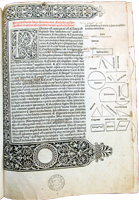3 et 4 juin 2019,
Oxford
Organisateurs :
Philip Beeley, Karine Chemla, Sally Humphreys, Agathe Keller, Yelda Nasifoglu, Benjamin Wardhaugh
Preclarissimus liber elementorum Euclidis perspicacissimi (Venice, 1482).
Bodleian Library Auct. K 3.19. Courtesy of the Reading Euclid project.
RATIONALE
Traditions in science throughout the ancient and the early modern world have regularly given specific texts the status of classics or canonical texts. In this respect, scientific disciplines embraced a practice that was more generally followed in all scholarly fields. However – paradoxically – while it has always been recognised that commentary served as a vehicle for innovative dialogue with the socially most authoritative texts (sacred writing, law), scholars have been much slower to appreciate that the same is true in other fields, and to focus attention on commentary as practice. This conference aims at deepening our understanding of how classics and canonical texts were perceived qua texts, by relying on scientific sources, and to study the forms and editions through which these specific types of text were presented to users. Our project further seeks to observe the various readings and interpretations that actors operating in different contexts made of these texts. For this, we will scrutinize several types of evidence, from marginalia left by readers to commentaries systematically composed on classics and canonical texts. In particular, we want to defamiliarize the concept of commentary, and anchor it in more specific social and cultural contexts. We welcome case studies dealing with sources written in any language of the ancient and early modern world. The conference will approach these questions from a multidisciplinary perspective, bringing various forms of approaches and competences to bear on these issues.
The conference is rooted in three projects that have been and are still developed at Oxford and Paris. Oxford project “Reading Euclid” deals with early modern English modes of reading of a classical work of mathematics, Euclid’s Elements, in its early modern editions. Paris-based project “Mathematical canons and commentaries” has aimed at understanding why and how mathematical activity in the ancient world has taken the shape of writing commentaries on canonical texts and which approaches to these canonical texts the commentaries testified to. Finally, Sally Humphreys has long developed a comparative and anthropological approach to ancient Greek classics ; and has organized two comparative projects : Cultures of scholarship (Univ. of Michigan Press 1997) and Modernity’s Classics (Springer 2013).





